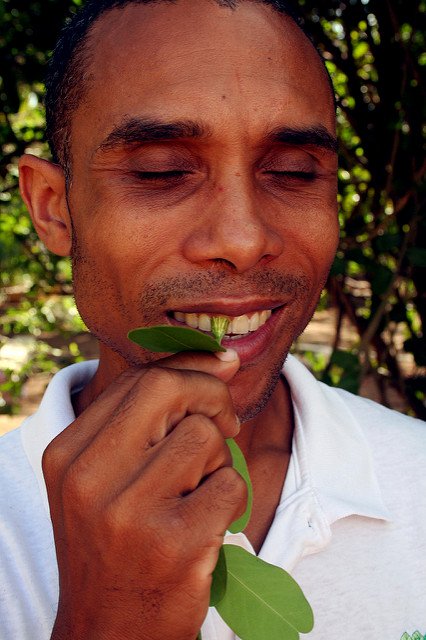The Uncommonly-Known Dental Benefits from a Small Evergreen Shrub: How the Toothbrush Tree Can Improve Dental Health
Did you know that a little evergreen shrub called the toothbrush tree may be the key to great dental health without the use of fluoride toothpaste? Learn more.

Photo by Sandor Weisz on Flickr.
Did you know that an evergreen shrub, native to hot, arid climates, contains antibacterial properties that can kill the bad bacteria in our mouths and fight bad breath? Studies have shown that this little shrub, in the form of a chewing stick, may effectively and exclusively replace the common toothbrush. It can even serve as a replacement for toothpaste.
Many popular toothpaste brands contain ingredients that are harmful to our health. But finding a non-toxic toothpaste in your local store isn't the easiest thing to do. For those individuals searching for healthy, natural alternatives to toothpaste, homemade toothpastes are an option. But are they really effective? Another potential problem with making our own toothpaste is maintaining proper consistency. Coconut oil toothpastes must be stored in cool places otherwise they melt into a runny consistency.
It appears that this evergreen shrub, however, may be the answer to all of our toothpaste problems.
The Toothbrush Tree and Its Benefits
So, what is this curious little plant?
This evergreen shrub or tree, often referred to as the "toothbrush tree", is scientifically called Salvadora persica and has actually been used for centuries as a natural toothbrush. Its fibrous branches have even been promoted by the World Health Organization for oral hygiene use.
There are a number of benefits of using the toothbrush tree. According to the American Preppers Network, dental health benefits include:
-
Kills bacteria that causes gum disease
-
Fights plaque effectively
-
Useful and effective for teeth whitening
-
Helps reduce tooth decay
-
Removes bad breath and odor from the mouth
-
Creates a fragrance in the mouth
-
Massages the gums for healthier teeth
-
Effectively cleans between teeth due to its parallel bristles
-
Increases salivation and inhibits dry mouth
The stems aren't the only part of the plant that are effective at maintaining good dental health. The plant's leaves are used as a mouthwash and for tooth and gum problems, and the bark is thought to contain an antibiotic that suppresses the growth of bacteria and the formation of dental plaque.
Other health benefits include its use as a medicine. The roots can be used for general body pain, gonorrhea, back pains, chest diseases, and stomach aches, and can even be prepared as a salve and rubbed on the face to tackle headaches. The latex from the bark is used to treat sores, the seeds are used as a tonic, and the seed oil, which contains lauric, myristic, and palmitic acids, is used on the skin for rheumatism. The leaves and bark contain trimethylamine, an alkaloid that has been used to treat cases of acute articular rheumatism.
Additionally, according to experts at the Norwich BioScience Institutes, the toothbrush tree has the ability to fight tuberculosis, a potentially serious infectious bacterial disease that mainly affects the lungs. It contains a compound that is thought to be beneficial in fighting this disease. An estimated 9 million people worldwide become sick with tuberculosis disease each year, and nearly 1.5 million deaths are attributed to tuberculosis.
This shrub can also be used in soap and candle making as well as it has a nice aroma.
History of the Toothbrush Tree
It is thought that the early Arabs, and Babylonian, Greek, and Roman societies used this toothbrush tree to clean their teeth. While it is native to a hot, arid climate like that in Africa, the Middle East and the Arabian Peninsula, it may be found in other locations as well. It is especially widespread in all districts of Tanzania, in thorn shrubs, desert flood plains, and grassy savannah.
The toothbrush tree can also be found in valleys, on dunes, and termite mounds, and where ground water is readily available on river banks, on the perimeters of waterholes, in seasonally wet sites, and along drainage lines in arid zones. This handy evergreen shrub has adapted to alkaline or saline-rich soils, usually rich with clay, and soils without salt. While it prefers clays, it can also be found on loams, black soils, and sand. This seemingly versatile plant can also be salt tolerant and drought resistant.
The Toothbrush Tree: Endorsed By the WHO
The World Health Organization (WHO) in 1987 recommended the discovery and apprehension for alternate oral practices, referencing chewing sticks in particular, and chewing sticks are still being endorsed as an effective tool for oral hygiene. These chewing sticks are particularly important for countries experiencing economic restraints as well as those with restricted oral health care services for the general population. Affordability and accessibility are two important aspects for urban and rural areas of developing countries.
In Pakistan, the main factor attributed to the selection of chewing sticks against the standard toothbrush is its acquisition by more than 50% of its population living in rural areas. Chewing sticks have been reported to be practiced by 90% of the rural population in Nigeria and Tanzania, 50% of Saudi Arabians, and 65% rural and 43% urban Indian population.
The Research Behind the Toothbrush Tree
Several studies have indicated that the use of miswak (also spelled siwak), the teeth cleaning twig made from the Salvadora persica shrub, effectively contributes to a significant reduction of dental plaque and gingivitis.
A randomized clinical study on the toothbrush tree was conducted to determine its effectiveness against the regular nylon toothbrush to remove dental plaque and improve gingival health after one month. The results showed that chewing sticks can effectively offer a diverse set of oral health benefits.
A new era of chewing sticks have been examined chemically and found to contain natural ingredients which are beneficial for oral health. These ingredients include ascorbic acid, trimethylamine, chloride, fluoride, silica, resins, and salvadorine, which have proved potency to heal inflamed and bleeding gums, produce stimulatory effect on gingiva, remove tartar and other stains from the teeth, remineralize dental hard tissue, whiten teeth, provide enamel barrier, and increase salivary flow.
Chewing sticks also contain volatile oils, including tannic acid, sulfur and sterols which attribute to antiseptic, astringent, and bactericidal properties that help reduce plaque formation, provide anti-carious effects, eliminate bad odor, improve the sense of taste, and cure many systemic diseases.
Another study was conducted to compare the effectiveness of the toothbrush tree as an oral disinfectant to that of traditional mouth rinsing. The investigation involved comparison of the reduction in malodor-related outcomes, anaerobic and aerobic bacteria, and volatile sulfur compounds (VSCs). Thirty-five healthy fasting volunteers took part in this clinical trial.
The researchers found that while the mouth rinsing protocol reduced the numbers of both aerobic and anaerobic bacteria, the Salvadora persica sticks could more selectively target the anaerobic Gram-negative bacteria, while preserving the aerobic Gram-positive bacteria. This means that the mouth rinsing solution killed both the bad bacteria and the good bacteria in the mouth. The Salvadora persica stick, however, preserved the good bacteria, which are believed to promote oral health. The aerobic bacteria include strains that have been shown to be beneficial for tooth decay, plaque formation, streptococcal pharyngitis, and oral malodor.
The study also found that both the Salvadora persica stick and the mouth rinsing protocol were effective in achieving initial reduction in VSCs. However, the VSC values reverted to high levels after five hours for the mouth rinsing protocol. The Salvadora persica protocol, on the other hand, was effective in reducing the VSC levels and the anaerobic bacteria throughout the nine-hour assessment period.
How Do You Use the Toothbrush Tree?
Using the toothbrush tree is simple and easy. All you do to use this natural toothbrush is trim or chew about a 1/2 inch of the bark off one end of the stick. Then continue to chew on the exposed end until the twig forms bristles, and then brush as usual, but with no toothpaste. When the bristles start to look like an old broom, usually every few days, cut off the exposed bristles, and then start again, chewing off the fresh end to form a new "set" of bristles.
Simply store the toothbrush in a clean place. If it becomes dry, it can be soaked in rose water to soften the end bristles.
Where Can You Buy the Toothbrush Tree?
You can buy seeds to grow your own toothbrush tree. The American Preppers Network recommends purchasing the sticks and seeds from MyHeirloomSeeds.com. Or you can also purchase herbal chewing sticks like those sold by the Miswak Club on Amazon.
Vacuum-sealed packages help maintain the sticks' freshness so they don't dry out. This is especially important for emergency preparedness practices, where the idea behind the practice is to prepare for product shortages. Dental health during an economic collapse or a survival situation probably won't be a major concern, but keeping our teeth clean after our toothpaste has run out should still be a consideration. We have seen how fast our dental health declines when we neglect our teeth for just a few days. Taking care of them every day, even in a crisis, will help prevent tooth aches and other inconvenient or painful dental health conditions.
Resources:
http://www.ncbi.nlm.nih.gov/pmc/articles/PMC4114011/
http://americanpreppersnetwork.com/2015/01/use-theres-no-toothpaste.html
http://www.fao.org/docrep/x5327e/x5327e1j.htm
http://www.lifesciencesite.com/lsj/life1110/008_25104life111014_44_48.pdf





